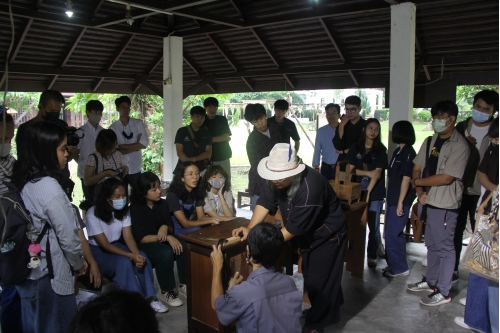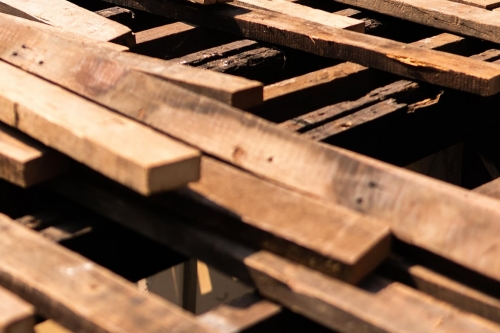การอนุรักษ์สถาปัตยกรรมล้านนาโบราณในเชียงใหม่ - เรือนกาแลพญาวงศ์ (งานซ่อมแซมพื้นเรือนและชานหลังเรือน)
การอนุรักษ์สถาปัตยกรรมล้านนาโบราณในเชียงใหม่ - เรือนกาแลพญาวงศ์ (งานซ่อมแซมพื้นเรือนและชานหลังเรือน)
เรือนกาแลพญาวงศ์มีลักษณะเป็นเรือนขนาดใหญ่ มีจั่วสองจั่ว ชาวล้านนาบางครั้งจะเรียกว่าแบบจั่วสองหลังร่วมพื้น ลักษณะของจั่วทั้งสอง ตรงปลายจั่วจะมีกาแลอยู่ด้านบน กลายเป็นที่มาของคำว่าเรือนกาแล เรือนกาแลพญาวงศ์หลังนี้ ถือเป็นตัวอย่างของเรือนกาแลในยุค 120 กว่าปี เพราะตัวอย่างที่หลงเหลือในจังหวัดเชียงใหม่เองมีเพียงไม่กี่หลังเท่านั้นที่มีความสมบูรณ์ได้ขนาดนี้
รูปแบบเรือน มีสองห้องนอนด้วยกัน ลักษณะของห้องนอนจะบอกได้ว่าถ้าเป็นจั่วใหญ่ก็จะเป็นห้องนอนหลัก เป็นของเจ้าของเรือน น่าจะเป็นที่อยู่ของพญาวงศ์ และอีกห้องที่มีจั่วขนาดเล็กลงที่อยู่ข้างๆ กัน อาจจะเป็นที่อยู่ของลูกสาว ครอบครัวลูกสาว หรือคนอื่นๆ ที่อยู่ในครอบครัว
ด้านหลังตัวเรือน จะมีห้องครัวแยกออกมา ซึ่งห้องครัวตรงส่วนนั้นจะมีการทำฝาที่มีความโปร่ง ใช้ไม้ไผ่สาน เพื่อให้อากาศ และควันเวลาทำกับข้าวระบายออกได้
ในส่วนของตัวเรือนจะมีงานเปลี่ยนพื้น พื้นภายในห้องซึ่งเป็นพื้นไม้เนื้อแข็ง
พื้นสำหรับในห้องของเรือนกาแลพญาวงศ์ถึงแม้จะไม่โดนฝนโดนแดด ก็มีสภาพที่ผุพังตามกาลเวลาเช่นกัน ไม้พอผ่านเวลาหลายปี หลายสิบปี ก็จะมีส่วนที่แตกหักไปตามกาลเวลาบ้าง หรือบางครั้งการเข้าชมของคน เหยียบย่ำไป ก็ทำให้เกิดการเสื่อมสภาพตามกาลเวลา
ก็จะทำการเปลี่ยน โดยจะเปลี่ยนส่วนที่แตกหักเป็นบางส่วน ซึ่งตงด้านล่างยังรองรับน้ำหนักได้ดีอยู่ ยังเป็นไม้ที่แข็งแรงทนทานอยู่ ก็ทำการเปลี่ยนเฉพาะไม้บางแผ่น เลือกบางแผ่นที่ทรุดโทรมมาก เปลี่ยนให้สวยงาม และรองรับการเข้าชมได้
สำหรับชานด้านหลัง ที่เชื่อมออกไปหาห้องครัว ก็จะทำการเปลี่ยนไม้ตงกับไม้แป้นปูเช่นเดียวกัน เนื่องจากพื้นที่ส่วนนี้มีหลังคาทั้งสองที่มาบรรจบกัน และไม่มีรางลินรองรับ เพราะฉะนั้นน้ำทั้งสองส่วนก็จะลงสู่พื้น ทำให้ไม้แป้นตรงนี้ผุพังได้ง่าย โดยเฉพาะจะมีปัญหามากในช่วงฤดูฝน จึงต้องทำการเปลี่ยนยกแผง รวมไปถึงตงที่อยู่ด้านล่าง
ไม้แป้น เวลาตีเข้าตง และหากตงแตกหัก มันจะตอกตะปูไม่เข้า ฉะนั้นจงต้องเปลี่ยนทั้งตงและไม้แป้นยกชุด
ในส่วนของชานด้านหลัง ซึ่งโดนแดด โดนฝนตลอดเวลา ก็ทำการรื้อเปลี่ยน โดยเปลี่ยนในส่วนของตัวพื้น ในส่วนของตงและคาน ส่วนของชานหลังก็จะมีเปลี่ยนเสาอยู่ 1 ต้น หลังจากที่รื้อถอนเสร็จก็ทำการตั้งเสา หลังจากนั้นก็ใส่คาน ใส่ตง และใส่พื้นตามลำดับ
ในส่วนของชานด้านหลังจะใช้เป็นไม้เนื้อแข็ง เพื่อความแข็งแรงและทนแดดทนฝน ระยะห่างระหว่างไม้แป้นพื้นแต่ละแผ่นที่ปูประมาณ 1.5 เซนติเมตร และก็มีเพิ่มเติมส่วนของการยึดราวบันไดให้แข็งแรง
ในส่วนฮ่อมลิน ช่องกลางระหว่างเรือน ก็ทำการเปลี่ยนพื้นใหม่ เพราะว่าค่อนข้างผุพัง
ในส่วนของผนังห้องครัว ก็ทำการเปลี่ยนใหม่ทั้งหมด โดยรื้อของเก่าออก และเปลี่ยนผนังใหม่เข้ามาแทนที่ โดยผนังที่เปลี่ยนเป็นไม้ไผ่สาน ที่ใช้ผิวของไม้ไผ่ ซึ่งต้องทำการสั่งทำและสานโดยช่างที่มีความชำนาญอย่างยิ่ง
ไม้ไผ่สานที่เลือกใช้เฉพาะเปลือกไม้ไผ่นั้น จะมีความทนทาน มีอายุการใช้งานใช้ได้หลายปี
Restoration work on Kalae Phayawong House (floor and back porch)
The Kalae Phayawong House is a large structure with two gables. At the end of both of the gables is a kalae carving, which is where the house gets its name from. The Kalae Phayawong House is an example of a kalae type house from more than 120 years ago. There are barely any of these houses left today that are in such good shape.
There are two bedrooms in this house. The bedroom with the larger gable is the master bedroom where the owner would sleep. This is probably where Phayawong stayed. The smaller bedroom is right next to the larger one, which might have been for the daughter and her family or for other family members.
At the back of the house is a kitchen. The walls in the kitchen are made to allow air to pass through. The woven bamboo makes it so the smoke won’t get trapped in the kitchen when cooking.
Inside the house, the floors were replaced with new hardwood.
Even though the floors on the inside of the Kalae Phayawong house were not exposed to the rain and sun, they were still damaged over time. Over so many years, wood can develop cracks on its own. The wood could also have been damaged by visitors walking on it.
Repairs were made by replacing the damaged sections of wood. The joists below were strong and durable and still able to support the weight of the floor. Only the most sunken or damaged boards needed to be replaced to make the floor beautiful and usable again.
For the back porch, which leads to the kitchen, the joists and floorboards needed replacing. This is where two rooves came together. There was no gutter to catch rainwater, so water that fell of both rooves ended up on the porch floor, causing it to decay, especially during the rainy season. The floors had to be raised and the joists changed.
When nailing floorboards into a joist, if the joist is broken, the nails won’t stay. Therefore, both the floorboards and the joists needed to be replaced for the back porch, which had been exposed to sun and rain for a long time. The wood was dismantled, and the joists and beams were replaced. One of the pillars was also replaced. After everything was dismantled, the pillar was placed, followed by the beams, the joists, and the floorboards.
Hardwood was used for the back porch because it is strong and can withstand sun and rain. The distance between the floorboards was about 1.5 cm. The stair railing was also more securely attached.
The floor also needed to be replaced in the middle of the house where the rooves came together because it was damaged.
The kitchen walls were totally replaced. The old ones dismantled and a new one put in place made of woven bamboo. This wall had to be constructed by a very skilled carpenter. The woven bamboo, made of the outer bamboo layer, is durable and can be used for many years.
ให้คะแนนบทความนี้
โดยการคลิกที่ดาว มากที่สุด = 5 ดาว
คะแนนทั้งหมด
คะแนน
จาก ครั้ง
5
4
3
2
1
เผยแพร่เมื่อ 12 เมษายน 2565 • การดู 1,432 ครั้ง
การอนุรักษ์สถาปัตยกรรมล้านนาโบราณในเชียงใหม่ - เรือนกาแลพญาวงศ์ (งานซ่อมแซมพื้นเรือนและชานหลังเรือน)
เรือนกาแลพญาวงศ์มีลักษณะเป็นเรือนขนาดใหญ่ มีจั่วสองจั่ว ชาวล้านนาบางครั้งจะเรียกว่าแบบจั่วสองหลังร่วมพื้น ลักษณะของจั่วทั้งสอง ตรงปลายจั่วจะมีกาแลอยู่ด้านบน กลายเป็นที่มาของคำว่าเรือนกาแล เรือนกาแลพญาวงศ์หลังนี้ ถือเป็นตัวอย่างของเรือนกาแลในยุค 120 กว่าปี เพราะตัวอย่างที่หลงเหลือในจังหวัดเชียงใหม่เองมีเพียงไม่กี่หลังเท่านั้นที่มีความสมบูรณ์ได้ขนาดนี้
รูปแบบเรือน มีสองห้องนอนด้วยกัน ลักษณะของห้องนอนจะบอกได้ว่าถ้าเป็นจั่วใหญ่ก็จะเป็นห้องนอนหลัก เป็นของเจ้าของเรือน น่าจะเป็นที่อยู่ของพญาวงศ์ และอีกห้องที่มีจั่วขนาดเล็กลงที่อยู่ข้างๆ กัน อาจจะเป็นที่อยู่ของลูกสาว ครอบครัวลูกสาว หรือคนอื่นๆ ที่อยู่ในครอบครัว
ด้านหลังตัวเรือน จะมีห้องครัวแยกออกมา ซึ่งห้องครัวตรงส่วนนั้นจะมีการทำฝาที่มีความโปร่ง ใช้ไม้ไผ่สาน เพื่อให้อากาศ และควันเวลาทำกับข้าวระบายออกได้
ในส่วนของตัวเรือนจะมีงานเปลี่ยนพื้น พื้นภายในห้องซึ่งเป็นพื้นไม้เนื้อแข็ง
พื้นสำหรับในห้องของเรือนกาแลพญาวงศ์ถึงแม้จะไม่โดนฝนโดนแดด ก็มีสภาพที่ผุพังตามกาลเวลาเช่นกัน ไม้พอผ่านเวลาหลายปี หลายสิบปี ก็จะมีส่วนที่แตกหักไปตามกาลเวลาบ้าง หรือบางครั้งการเข้าชมของคน เหยียบย่ำไป ก็ทำให้เกิดการเสื่อมสภาพตามกาลเวลา
ก็จะทำการเปลี่ยน โดยจะเปลี่ยนส่วนที่แตกหักเป็นบางส่วน ซึ่งตงด้านล่างยังรองรับน้ำหนักได้ดีอยู่ ยังเป็นไม้ที่แข็งแรงทนทานอยู่ ก็ทำการเปลี่ยนเฉพาะไม้บางแผ่น เลือกบางแผ่นที่ทรุดโทรมมาก เปลี่ยนให้สวยงาม และรองรับการเข้าชมได้
สำหรับชานด้านหลัง ที่เชื่อมออกไปหาห้องครัว ก็จะทำการเปลี่ยนไม้ตงกับไม้แป้นปูเช่นเดียวกัน เนื่องจากพื้นที่ส่วนนี้มีหลังคาทั้งสองที่มาบรรจบกัน และไม่มีรางลินรองรับ เพราะฉะนั้นน้ำทั้งสองส่วนก็จะลงสู่พื้น ทำให้ไม้แป้นตรงนี้ผุพังได้ง่าย โดยเฉพาะจะมีปัญหามากในช่วงฤดูฝน จึงต้องทำการเปลี่ยนยกแผง รวมไปถึงตงที่อยู่ด้านล่าง
ไม้แป้น เวลาตีเข้าตง และหากตงแตกหัก มันจะตอกตะปูไม่เข้า ฉะนั้นจงต้องเปลี่ยนทั้งตงและไม้แป้นยกชุด
ในส่วนของชานด้านหลัง ซึ่งโดนแดด โดนฝนตลอดเวลา ก็ทำการรื้อเปลี่ยน โดยเปลี่ยนในส่วนของตัวพื้น ในส่วนของตงและคาน ส่วนของชานหลังก็จะมีเปลี่ยนเสาอยู่ 1 ต้น หลังจากที่รื้อถอนเสร็จก็ทำการตั้งเสา หลังจากนั้นก็ใส่คาน ใส่ตง และใส่พื้นตามลำดับ
ในส่วนของชานด้านหลังจะใช้เป็นไม้เนื้อแข็ง เพื่อความแข็งแรงและทนแดดทนฝน ระยะห่างระหว่างไม้แป้นพื้นแต่ละแผ่นที่ปูประมาณ 1.5 เซนติเมตร และก็มีเพิ่มเติมส่วนของการยึดราวบันไดให้แข็งแรง
ในส่วนฮ่อมลิน ช่องกลางระหว่างเรือน ก็ทำการเปลี่ยนพื้นใหม่ เพราะว่าค่อนข้างผุพัง
ในส่วนของผนังห้องครัว ก็ทำการเปลี่ยนใหม่ทั้งหมด โดยรื้อของเก่าออก และเปลี่ยนผนังใหม่เข้ามาแทนที่ โดยผนังที่เปลี่ยนเป็นไม้ไผ่สาน ที่ใช้ผิวของไม้ไผ่ ซึ่งต้องทำการสั่งทำและสานโดยช่างที่มีความชำนาญอย่างยิ่ง
ไม้ไผ่สานที่เลือกใช้เฉพาะเปลือกไม้ไผ่นั้น จะมีความทนทาน มีอายุการใช้งานใช้ได้หลายปี
Restoration work on Kalae Phayawong House (floor and back porch)
The Kalae Phayawong House is a large structure with two gables. At the end of both of the gables is a kalae carving, which is where the house gets its name from. The Kalae Phayawong House is an example of a kalae type house from more than 120 years ago. There are barely any of these houses left today that are in such good shape.
There are two bedrooms in this house. The bedroom with the larger gable is the master bedroom where the owner would sleep. This is probably where Phayawong stayed. The smaller bedroom is right next to the larger one, which might have been for the daughter and her family or for other family members.
At the back of the house is a kitchen. The walls in the kitchen are made to allow air to pass through. The woven bamboo makes it so the smoke won’t get trapped in the kitchen when cooking.
Inside the house, the floors were replaced with new hardwood.
Even though the floors on the inside of the Kalae Phayawong house were not exposed to the rain and sun, they were still damaged over time. Over so many years, wood can develop cracks on its own. The wood could also have been damaged by visitors walking on it.
Repairs were made by replacing the damaged sections of wood. The joists below were strong and durable and still able to support the weight of the floor. Only the most sunken or damaged boards needed to be replaced to make the floor beautiful and usable again.
For the back porch, which leads to the kitchen, the joists and floorboards needed replacing. This is where two rooves came together. There was no gutter to catch rainwater, so water that fell of both rooves ended up on the porch floor, causing it to decay, especially during the rainy season. The floors had to be raised and the joists changed.
When nailing floorboards into a joist, if the joist is broken, the nails won’t stay. Therefore, both the floorboards and the joists needed to be replaced for the back porch, which had been exposed to sun and rain for a long time. The wood was dismantled, and the joists and beams were replaced. One of the pillars was also replaced. After everything was dismantled, the pillar was placed, followed by the beams, the joists, and the floorboards.
Hardwood was used for the back porch because it is strong and can withstand sun and rain. The distance between the floorboards was about 1.5 cm. The stair railing was also more securely attached.
The floor also needed to be replaced in the middle of the house where the rooves came together because it was damaged.
The kitchen walls were totally replaced. The old ones dismantled and a new one put in place made of woven bamboo. This wall had to be constructed by a very skilled carpenter. The woven bamboo, made of the outer bamboo layer, is durable and can be used for many years.
โดยการคลิกที่ดาว มากที่สุด = 5 ดาว
คะแนนทั้งหมด
คะแนน จาก ครั้ง
| 5 | |
| 4 | |
| 3 | |
| 2 | |
| 1 |
เมนู
วิดีโออื่นๆ ที่น่าสนใจ


ลมหายใจของการอนุรักษ์ เรือนโบราณสันป่าตอง 2 (แม่ครูทองสาย เล็กตระกูล) - The Breath of Conservation Sanpatong Folk House 2, Mae Kru Tongsai Lektragoon

การเข้าปากไม้รูปกากบาท - Joining wooden boards in an X shape
